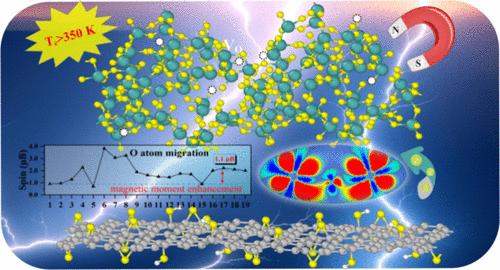2D Amorphous Heterointerface Engineering for Enhanced Ferromagnetism in MoO3–x/Graphene Oxide
IF 3.2
3区 化学
Q2 CHEMISTRY, PHYSICAL
引用次数: 0
Abstract
Two-dimensional (2D) amorphous materials have broad potential for applications in magnetic property modulation and functional material design due to their unique electronic structures and abundant surface defects. However, the challenge of achieving room-temperature ferromagnetism in these materials limits their application in spintronics. In this study, a heterostructure between 2D amorphous molybdenum oxide (MoO3–x) and graphene oxide (GO) was constructed, achieving room-temperature ferromagnetism with a Curie temperature of greater than 350 K. The influence of interfacial oxygen atom migration on the distribution of oxygen vacancies and the modulation of magnetic properties was systematically investigated. The results indicate that interfacial charge transfer significantly modulated the Mo d-electron states, activating the ferromagnetic activity of MoO3–x. Moreover, carbon defects at the heterointerface induced oxygen atom migration, further enhancing the ferromagnetic behavior. This work provides atomic-scale insights into the magnetic regulatory mechanism of 2D amorphous ferromagnetic oxide materials by heterointerface engineering, offering new strategies for the design and application of 2D magnetic amorphous materials and expanding their potential applications in spintronics.

MoO3-x /氧化石墨烯增强铁磁性的二维非晶异质界面工程
二维非晶材料由于其独特的电子结构和丰富的表面缺陷,在磁性调制和功能材料设计方面具有广阔的应用前景。然而,在这些材料中实现室温铁磁性的挑战限制了它们在自旋电子学中的应用。在本研究中,构建了二维非晶氧化钼(MoO3-x)和氧化石墨烯(GO)之间的异质结构,实现了居里温度大于350 K的室温铁磁性。系统地研究了界面氧原子迁移对氧空位分布和磁性能调制的影响。结果表明,界面电荷转移显著调节了Mo电子态,激活了MoO3-x的铁磁活性。此外,异质界面处的碳缺陷诱导氧原子迁移,进一步增强了铁磁性。本研究通过异质界面工程在原子尺度上深入了解二维非晶铁磁氧化物材料的磁调控机制,为二维非晶磁性材料的设计和应用提供了新的策略,并扩大了其在自旋电子学中的潜在应用。
本文章由计算机程序翻译,如有差异,请以英文原文为准。
求助全文
约1分钟内获得全文
求助全文
来源期刊

The Journal of Physical Chemistry C
化学-材料科学:综合
CiteScore
6.50
自引率
8.10%
发文量
2047
审稿时长
1.8 months
期刊介绍:
The Journal of Physical Chemistry A/B/C is devoted to reporting new and original experimental and theoretical basic research of interest to physical chemists, biophysical chemists, and chemical physicists.
 求助内容:
求助内容: 应助结果提醒方式:
应助结果提醒方式:


